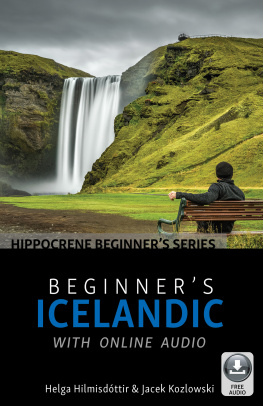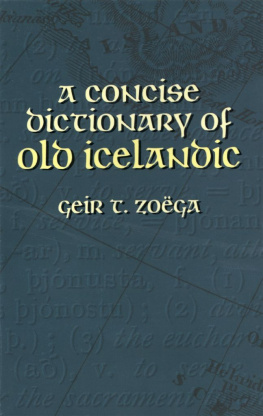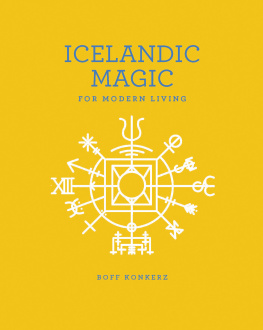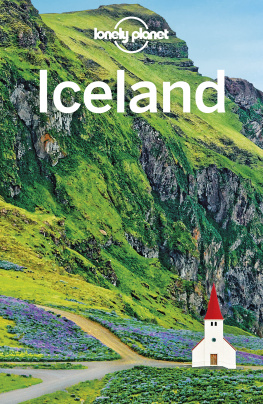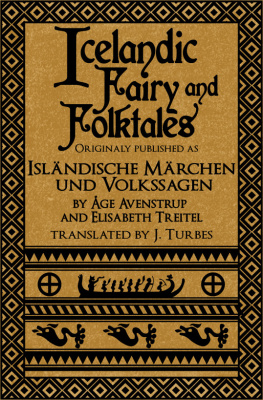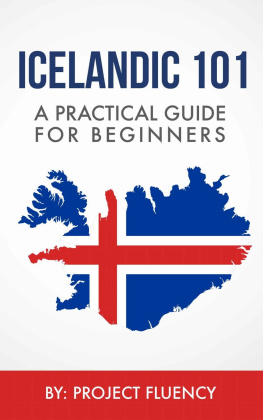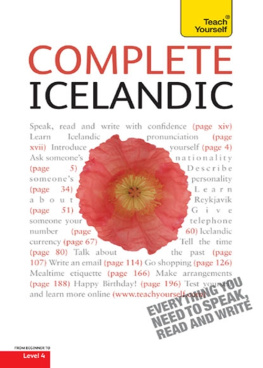
BEGINNERS
Icelandic
WITH Online AUDIO
BEGINNERS
Icelandic
WITH Online AUDIO
Helga Hilmisdttir
and
Jacek Kozlowski
HIPPOCRENE BOOKS, INC.
New York
Audio files available at www.hippocrenebooks.com
Online Audio edition, 2020
Text Copyright 2009 Helga Hilmisdttir and Jacek Kozlowski
Audio Copyright 2009 Hippocrene Books
All rights reserved. No portion of this book may be reproduced, by any process or technique, without the express written consent of the publisher.
For information, address:
HIPPOCRENE BOOKS, INC.
171 Madison Avenue
New York, NY 10016
www.hippocrenebooks.com
ISBN 978-0-7818-1415-7
Previous edition ISBN: 978-0-7818-1191-0
Printed in the United States of America.
TABLE OF CONTENTS

| Audio files available for download at: http://www.hippocrenebooks.com/beginners-online-audio.html |
INTRODUCTION
People
Icelandic is the language of Iceland, a European island nation in the North Atlantic. It is a Nordic country and thus shares cultural and political ties with the Faroe Islands, Denmark, Norway, Sweden, Finland, and Greenland. Icelandic is a Germanic language, and so it is related to the Scandinavian languages as well as English and German.
As of January 2007, Iceland had approximately 300,000 inhabitants of which approximately 190,000 or 65 percent lived in the capital city Reykjavik and its surrounding areas. The countrys population rose by 2.2 percent in 2005. The overall population density is the lowest in Europe with only three inhabitants per square kilometer. The inner, mountainous, and glacial part of the country is not inhabited, and most populations are around the coastal regions.
The only city in Iceland is Reykjavik. The only urban area outside of the capital is Akureyri which has approximately 15,000 inhabitants. Other towns are considerably smaller. Iceland is divided into 23 counties (ssla). Within these counties there are 98 municipalities (sveitarflag).
Icelandic Names
Icelanders use a naming convention whereby the fathers or mothers first name is combined with the words for son or daughter (son or dttir) to form a second name. Thus, the singer Bjrks full name is Bjrk Gumundsdttir, which literally translates to Bjrk, daughter of Gumundur. This might seem a bit strange to English speakers and other foreigners, since it means that siblings often dont have the same last names. Bjrks brother, for example, would have Gumundsson as a second name. To make things more complex, different generations have different last names since fathers and grandfathers dont have the same first names. Thus, if your grandfathers name were Jn, your father would have Jnsson as a second name, and if your fathers first name were Steingrmur, your last name would be Steingrmsson or Steingrmsdttir. People are listed in the phone book by their first names.
Geography
Iceland is 103,000 square kilometers in area of which 11.5 percent is covered by glaciers. It contains the largest glacier in Europe, Vatnajkull. Vatnajkull reaches a thickness of 1,000 meters at its thickest point. In recent years, many of the glaciers have been retreating. Iceland is a geologically young country with many active volcanoes, and earthquakes are common. For example, Surtsey Island in the south part of the country was born just a few decades ago from an undersea volcanic eruption.
The country has a very small amount of wood and trees. In recent years, Icelanders have put a great deal of effort into planting new trees.
Climate
Iceland experiences a typically maritime climate which is quite mild because of the influence of the Gulf Stream. The annual average temperature in Iceland is approximately 5C or 41F. The weather changes rapidly and it is recommended to bring warm clothes when travelling to Iceland, even in the summer.
Due to Icelands northern position, the days are very long in the summer and very short in the winter. The Midnight Sun can be seen for approximately ten weeks in the summer months. From mid-November to the end of January, daylight lasts for only three to four hours.
The northern lights are often seen in Iceland, especially in rural parts of the island.
History
Iceland was settled in 874 A.D. and adopted Christianity in the year 1000. In 930, Iceland formed the Alingi (Althingi), the oldest active parliament in the world. The country lost its independence in 1262 when it was ruled by Norway. In 1387, Danish rule succeeded Norwegian rule, and this lasted until home rule was awarded in 1904 and autonomy in 1918. Iceland was still officially under the Danish king from 1918 to 1944 and became fully independent in 1944 during World War II. In 1949, Iceland became a charter member of NATO. Iceland is a member of the Common Market of the European Union and has signed the European Economic Area agreement but is, as of 2007, not a member of the European Union.
Government
The president is the head of the state. However, the day-to-day role of the president is primarily symbolic in nature. As of this writing, the president of Iceland is Dr. lafur Ragnar Grmsson. Icelanders often pride themselves on having elected the first female president in the world, Vigds Finnbogadttir, who was elected president in 1980.
All legislative power is exercised by the Alingi, which is elected every four years and consists of 63 members. The five major parties are, from left to right, The Left-Green movement (Vinstrihreyfingin grnt frambo), The Social-Democratic Alliance (Samfylkingin), The Progressive Party (Framsknarflokkurinn), The Liberal Party (Frjlslyndi flokkurinn), and The Independence Party (Sjlfstisflokkurinn).
Economy
In the past, Icelands economy depended mainly on the fishing industry. This is, to a large extent, still true today, though fishing quotas and declining fish stocks have lessened the importance of the industry as a whole.
Today tourism, entertainment, software production, biotechnology, and financial services are all growing sectors. Most of the countrys power is produced from hydro or geothermal sources.
Religion
The state church in Iceland is the Evangelical Lutheran Church. The majority of the population, 92.2 percent, is Evangelical Lutheran, with other Lutherans making up an additional 3.1 percent. Roman Catholics account for 0.9 percent of the population. There is also a Catholic church in Reykjavik and a number of churches for other groups.
Literature and the Arts
Iceland has one of Europes highest literacy rates, and Icelanders pride themselves on their literary history. The Sagas, prose narratives of historic or legendary figures and events of the heroic age of Norway and Iceland, were written from 12001350. A selection of the original manuscripts can be viewed at the Culture House in Reykjavik.
Iceland has had one Nobel Prize winner for literature, Halldr Kiljan Laxness (19021998). Among his most acknowledged works are the novels Independent People (Sjlfsttt flk 19345) and The Bell of Iceland (slandsklukkan 19436). Some of his novels have been adapted for the screen, for example The Atom Station (
Next page
